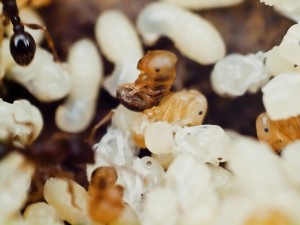When you think of spring, you probably envision blooming flowers and the return of warmer weather. But in the pest control industry, spring marks the beginning of peak pest season, when most insects are coming out of their winter hiding spots, mating – and in some cases – finding their way into our homes. Unfortunately, one of the most common springtime pests is also one of biggest threats to our homes and properties – termites.
- Home
- About
- Bugs
- Residential
- Commercial
- Services
- Real Estate Inspections
- Special Offers
- Locations
- Quote
- Blog
- Contact
- Home
- About
- Bugs
- Residential
- Commercial
- Services
- Real Estate Inspections
- Special Offers
- Locations
- Quote
- Blog
- Contact
Tag: ant infestations
Ant Problems in your House?
Written by webadmin on . Posted in Permatreat Blog.
Ants are social insects, they live together in cooperative, intermingling colonies. The colonies may range in size from hundreds to millions of individuals, depending on the species. Within each colony are different types of individuals, each with a specific function. All ant colonies contain one or more queens, whose primary role is to lay eggs.

 The eggs hatch into white, grub-like larvae that later transform into adult “worker” ants. The workers feed and care for the queens and developing brood, and are the ones seen foraging for food and water, often at great distances from the colony. Ants lay down invisible odor trails, which the workers follow between food and the nest. In many species, the trail of ants is distinct enough to be followed back to the nesting location, or to where the ants are entering from outdoors.
The eggs hatch into white, grub-like larvae that later transform into adult “worker” ants. The workers feed and care for the queens and developing brood, and are the ones seen foraging for food and water, often at great distances from the colony. Ants lay down invisible odor trails, which the workers follow between food and the nest. In many species, the trail of ants is distinct enough to be followed back to the nesting location, or to where the ants are entering from outdoors.
At certain times of the year, ant colonies produce large numbers of winged individuals known as swarmers. These winged ants emerge from the nest to mate and establish new colonies. When a swarm of ants emerges inside a home, it’s an indication that a nest is present within the structure. Fortunately, the success rate for swarmers establishing new colonies inside buildings is low. Quite often winged ants emerging indoors can be disturbing and often mistaken for termites.
Winged ants can be distinguished from termites by comparing certain features. Ants have a narrow (pinched) waist similar to wasps, whereas termites are virtually the same width from end to end. Ants and termites each have four wings; however, on ants the front wings are longer than the hind wings while on termites all four wings are of equal size and length. Finally, the antennae of ants are bent or “elbowed” whereas termite antennae are straight.
 Buildings contain many favorable hiding and nesting sites for ants. Preferred sites include spaces behind walls, cabinets, and appliances; behind window and door frames; and beneath floors and concrete slabs. Most of these areas are hidden, making it difficult to determine their precise location.
Buildings contain many favorable hiding and nesting sites for ants. Preferred sites include spaces behind walls, cabinets, and appliances; behind window and door frames; and beneath floors and concrete slabs. Most of these areas are hidden, making it difficult to determine their precise location.
Ants noticed inside the home may actually be nesting outdoors in the yard. You can try to trace the ants back to the point where they are entering from outside. This may be along a window sill, beneath an entrance door, or where the exterior siding meets the foundation wall. Ants usually prefer to trail along lines and edges. When tracing ant trails indoors or outdoors, pay particular attention to cracks, seams, and edges created by baseboards, the tack strip beneath perimeter edges of carpeting, mortar joints, the foundation- siding interface, etc. Nests often will be located in the ground, marked by a mound or anthill. Other times, the nests will be concealed under mulch, gravel, stones, landscaping timbers, pavement, or beneath the grass edge adjoining the foundation wall of the building. Some kinds of ants prefer to nest behind exterior siding or wood trim that has been damaged by moisture. While it takes patience to locate an ant colony outdoors, results will be more rapid and permanent than if you only spray where ants are seen trailing.
 One way to entice ants to reveal the location of their hidden nest(s) outdoors or indoors, is to place small dabs of honey or jelly on an index card, etc., next to where ants are observed. After the ants have fed, they will head back to the nest.
One way to entice ants to reveal the location of their hidden nest(s) outdoors or indoors, is to place small dabs of honey or jelly on an index card, etc., next to where ants are observed. After the ants have fed, they will head back to the nest.
Ants build their nests in many different locations both inside and outside of buildings. Species nesting inside, or foraging indoors for food or moisture, tend to be the most challenging to control.
To learn more about the different types of ants that may infest your home in Virginia CLICK HERE.
For a free, no obligation inspection CLICK HERE.
PermaTreat Pest and Termite Control
Are pests invading your home? Call PermaTreat now at 866-737-6287 for a home inspection today!
Contact Us
Find Us
© All Rights Reserved.


































































